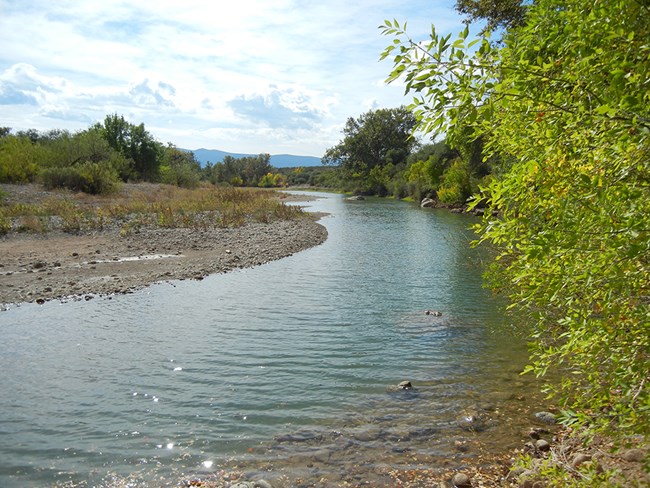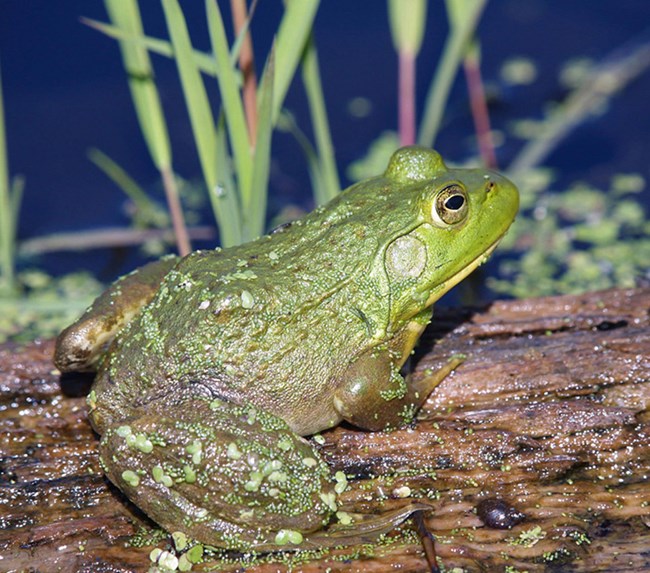
Overview
President Theodore Roosevelt established Montezuma Castle National Monument on December 8, 1906, to preserve the prehistoric structure known as Montezuma's Castle and the lands necessary for its protection. In 1943, Congress authorized the acquisition of additional lands containing Montezuma Well to become a detached unit of the monument. The location of these important cultural resources is directly related to vital natural resources: the perennial waters of Beaver Creek, and the aquatic sinkhole at Montezuma Well. Natural resource issues of concern include adjacent land use, development, and water use. Exotic invasive species are also an issue.
The Sonoran Desert Network monitors air quality, climate, groundwater, invasive exotic plants, landbirds, springs, seeps, and tinajas, streams, and vegetation and soils at Montezuma Castle National Monument. The results of this work can be found in a variety of publications and other information. The network also maintains species lists for the park.
Park Setting and Key Resources
Size: 347 hectares
Elevation range: 963–1,103 meters
Biogeography and physiography
Montezuma Castle National Monument spans only about 300 feet in elevation but includes diverse ecosystems. Lush aquatic and riparian ecosystems are associated with Beaver Creek, Wet Beaver Creek, and Montezuma Well. Elsewhere, dry, sparse upland thornscrub communities are separated by steep limestone cliffs. The monument lies in the Apache Highlands ecoregion. This region, characterized by mountain "sky islands" separated by grassland and desert scrub "seas," spans 30 million acres in Arizona, New Mexico, and Sonora and Chihuahua, Mexico. Montezuma Castle National Monument is part of the thornscrub biome.

Local geology and soils
Soil properties influence vegetation composition, persistence, and productivity. Two broad types of soils predominate at Montezuma Castle National Monument: (1) riverine bottomland alluvium and (2) rocky upland soils. Riverwash soils along Beaver Creek consist of stratified sand, silt, and clay, with scattered deposits of gravel, cobbles, stones, and boulders. In non-riparian areas, the Retriever soil series, consisting of limestone outcrops and soils, dominates the soils derived from calcareous parent materials at the Castle unit. The rest of the Castle unit is characterized by several series of finer calcareous soils, including fine sandy loams, gravelly sandy loams, and clays. However, soil properties can vary greatly over relatively small areas that may not be adequately captured by traditional soil surveys.
Biological soil crusts
Biological soil crusts are a community of cyanobacteria, algae, lichens, and bryophytes that live on the ground. They provide key ecosystem functions—resisting water and wind erosion, contributing organic matter, and fixing atmospheric nitrogen. Cyanobacteria weave through the upper few millimeters of soil, secreting polysaccharides and binding soil particles together. Mosses and lichens have small, anchoring structures that help them protect the soil surface.
At Montezuma Castle National Monument, cyanobacteria dominate the crust community on non-rocky soils derived from limestone. Lichens, comprising a fungus and either a cyanobacterium or a green alga, occur on the soil surface. Nine lichens and five mosses have been observed on monument soils.

NPS/Alice Wondrak Biel
Climate and hydrology
Climate at Montezuma Castle National Monument is typical of the Apache Highlands Ecoregion. The monument receives highly variable precipitation. Daily and seasonal air temperatures have a wide range. Potential evapotranspiration is relatively high. Approximately half of the annual precipitation falls during summer, when maximum air temperatures often exceed 86°F and lead to violent (and often localized) rainstorms. The bulk of the remaining annual precipitation falls in relatively gentle events of broad extent, occasionally as snow. Recent (1981–2010) historic, or "normal" average annual precipitation is 14.35 inches. Average maximum temperature is 81.2°F, and average minimum temperature is 43.6°F.
Weather and climate data for Montezuma Castle National Monument and all other Sonoran Desert Network parks can be found at The Climate Analyzer, an interactive website that allows users to create custom graphs and tables from historical and current weather-station data. A weather and climate inventory was created for the Sonoran Desert Network in 2007. A more recent brief shows the magnitude and direction of ongoing changes in climate at the monument.
Human habitation
Beginning around 900 AD, the valleys and hills along the Verde River were settled by a sequence of Hohokam, Hakataya, and Sinagua peoples. The Sinagua built and occupied the Montezuma Castle cliff-house complex from around 1200 to 1400 AD. They also farmed some of the fertile, flat land along the creeks, beginning around AD 600–800. European settlers resumed cultivation in the 1800s.
Today, the Southwest is one of the fastest-growing regions in the United States. Population in the Verde River watershed increased from approximately 82,000 in 1990 to about 148,000 from 2005 to 2009.
Key Issues
Adjacent land use, development, and water use
Adjacent land development affects the monument directly and indirectly. Potential impacts include the introduction of non-native species, increased groundwater withdrawal, surface water-quality problems and pollution, and visual intrusions to the natural landscape.
Groundwater and spring discharge contribute to the perennial flow in Beaver Creek. Adjacent land uses can interrupt these natural flow regimes. Increased well-drilling has lowered groundwater levels. Agricultural irrigation also affects the amount of creek water flowing through both units of the monument. Water quality can be affected by non-point source pollution, agricultural and livestock runoff, and septic wastewater discharge.

Photo by Russ Ottens; University of Georgia; Bugwood.org
Invasive exotic species
Non-native grasses, such as red brome (Bromus rubens) and ripgut brome (Bromus diandrus), are well-established in the Verde Valley. Exotic plant inventories of monument lands found 43 exotic plant species within the Castle unit.
Non-native animals include feral dogs and cats, cattle, European starlings, house sparrows, and bullfrogs. Non-native fish, crayfish, and the American bullfrog (Lithobates catesbeiana) may be causing declines in abundance and the extirpation of native fish, amphibians, and some aquatic reptiles. A 1995 study reported five non-native fish species in Wet Beaver Creek.
Quick Reads
Source: NPS DataStore Saved Search 4934. To search for additional information, visit the NPS DataStore.
Source: NPS DataStore Saved Search 4933. To search for additional information, visit the NPS DataStore.
Last updated: November 1, 2022
